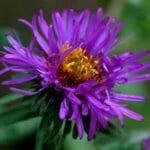Lessons from the Prairie

Five years ago, my family planted a prairie in our front yard. It’s only a small swatch, but the lessons it provides have been huge. Our prairie is a study in resiliency. Three inches of rain in a night? The prairie thrives. No rain at all for months? The prairie thrives. Cloudiness and cool temps? No problem. Blazing heat and the near drought we are having now? Bring it on. This little prairie has even survived the fall of the neighbor’s 150-year oak (the grasses underneath battered but not even broken for the year).
What lessons does the prairie offer? The benefits of diversity. Conditions are always optimal for some of the four grasses and 15 forbs we planted. The prairie species grow and mature at different times, and harvest solar energy from early May until well after frost.
Another lesson of the prairie: Perenniality. According to Laura Jackson, “Perennial means that the plants come up from roots year after year instead of from seed, and as a consequence the physical structure of the vegetation—dry plant litter, crowns, and roots—protects the soil from erosion.” Laura, a PFI member and University of Northern Iowa biology professor, is co-author with her mother, Dana Jackson, of a wonderful book, The Farm as Natural Habitat.
Many Practical Farmers are working to mimic the prairie’s diversity and perenniality in your farming systems. 32 percent of you report you have three-plus year rotations. 45 percent of you report you are using cover crops. 41 percent of you report you rotationally graze your livestock.
Part of Practical Farmers’ work is to help farmers solve the challenges to making those longer rotations, cover crops, and grazing systems work for their triple bottom line (profitability, stewardship, and community).
We are always proud of Practical Farmers, but we were just beaming at a Leopold Center conference last May. The centerpiece of the keynote speaker’s talk on resiliency was PFI’s own Gilbert Family and how their farm has withstood shocks that have included severe flooding, hail, low milk prices, and escalating input costs.
The Gilberts, who own 800 acres near Iowa Falls, have a dairy herd, antibiotic-free hogs, and corn, food-grade soybeans, alfalfa-grass hay, oats and a variety of annuals for forage. Among the Gilberts’ strategies for resiliency:
• Working with nature to time when calves and pigs are born;
• Selecting livestock and crop varieties that are hardy with minimal inputs;
• Choosing breeding stock with calm dispositions for easier handling;
• Relying first on on-farm resources and skills;
• Being financially cautious, and
• Managing risks with insurance whenever possible.
